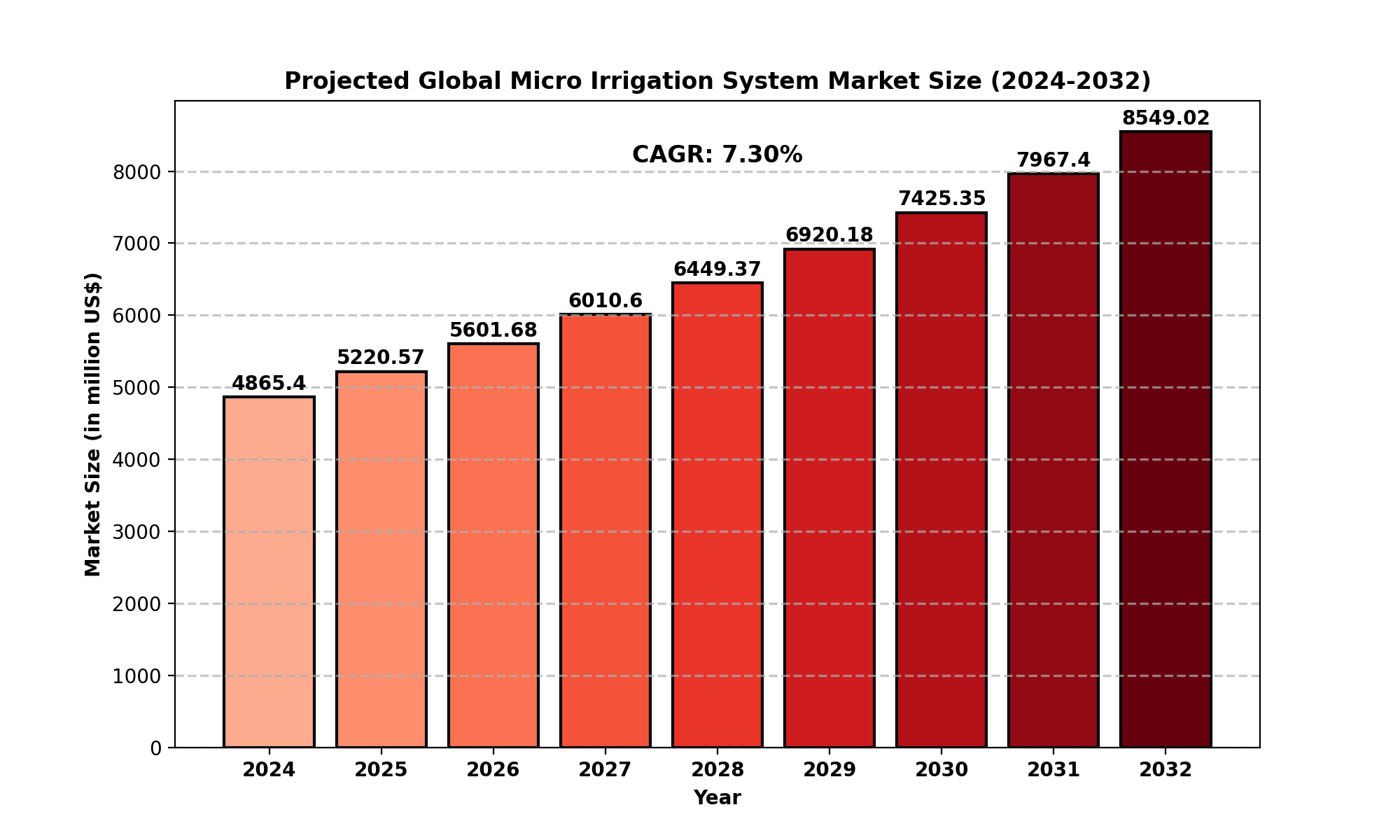TOP CATEGORY: Chemicals & Materials | Life Sciences | Banking & Finance | ICT Media

Download Report PDF Instantly
Report overview
Micro-irrigation, also known as localized irrigation, low volume irrigation, low-flow irrigation, or trickle irrigation, is an advanced irrigation technique that delivers water directly to the roots of plants with minimal wastage. It operates at lower pressure and flow compared to traditional sprinkler systems. This efficient system is commonly used in agriculture for row crops, orchards, and vineyards, as well as in horticulture for wholesale nurseries and landscaping in both civic and private settings. Additionally, it is essential in restoration ecology and environmental remediation, offering a sustainable solution to water management.
Micro-irrigation systems are designed to maximize water usage efficiency, reduce evaporation, and prevent surface runoff, making them an optimal choice for arid regions and areas facing water scarcity. The systems can be customized based on the specific needs of different crops, ensuring that each plant receives the right amount of water to thrive.
The global Micro Irrigation System market was valued at approximately USD 4.87 billion in 2024 and is projected to grow to USD 8.54 billion by 2032, exhibiting a compound annual growth rate (CAGR) of 7.30% during the forecast period.
North America’s micro-irrigation system market size is expected to reach USD 1.43 billion in 2024, growing at a CAGR of 6.26% from 2025 through 2032. The global market's growth is driven by increasing adoption in agriculture, the need for efficient water use, and the growing awareness of water conservation. Furthermore, the rise in demand for high-quality crops and sustainable farming practices fuels the growth of this market.

Drivers
Several factors are driving the growth of the global micro-irrigation system market:
Water Conservation: As water scarcity becomes a global concern, the demand for efficient irrigation solutions like micro-irrigation systems increases. These systems use up to 50% less water compared to traditional irrigation techniques.
Advancements in Technology: Technological innovations in drip and sprinkler systems have made micro-irrigation more effective and accessible for a broader range of users. Remote monitoring systems, soil moisture sensors, and automated irrigation control have enhanced the precision and efficiency of these systems.
Government Support and Subsidies: Governments worldwide are promoting micro-irrigation systems through subsidies and financial incentives to address water management issues in agriculture.
Environmental Concerns: With increasing awareness about environmental sustainability, farmers are opting for water-efficient irrigation methods, which micro-irrigation provides.
Restraints
While the market is growing, there are certain restraints that may hinder the full potential of the micro-irrigation systems:
High Initial Investment: The setup cost for micro-irrigation systems can be high, especially for small farmers or regions with limited budgets. This factor may limit adoption in developing regions.
Complex Installation and Maintenance: Micro-irrigation systems require technical expertise for installation and ongoing maintenance, which can be challenging in rural and remote areas.
Climatic Conditions: The efficiency of micro-irrigation systems can be impacted by extreme weather conditions, such as flooding, heavy rainfall, or temperature fluctuations, potentially affecting their overall effectiveness.
Opportunities
The market presents multiple opportunities for growth and expansion:
Emerging Markets: Developing regions, such as Asia-Pacific, Latin America, and Africa, have untapped potential for micro-irrigation solutions due to the increasing need for efficient water management in agriculture.
Integration with Smart Technologies: The integration of IoT and smart farming technologies with micro-irrigation systems presents a significant growth opportunity. Farmers can monitor and adjust water usage remotely, increasing the system’s efficiency and reducing costs.
Expansion in Horticulture and Landscaping: The use of micro-irrigation in horticulture and landscaping is expanding rapidly, particularly in urban areas where water management is a key concern.
Challenges
Despite the promising growth prospects, several challenges could impact the micro-irrigation system market:
Lack of Awareness: In some regions, farmers are unaware of the advantages of micro-irrigation systems. Overcoming this barrier requires educational programs and government initiatives to highlight the benefits of these systems.
Technological Barriers: Not all regions have access to the necessary technological infrastructure to fully implement advanced micro-irrigation systems. Bridging the technological gap is essential for market growth.
North America
The North American market is a significant contributor to the global growth of micro-irrigation systems. The increasing demand for efficient water use in agriculture, particularly in the United States and Canada, drives market growth. Additionally, government policies encouraging sustainable farming practices help propel the market.
Europe
Europe is witnessing growth due to increasing awareness about environmental sustainability and the efficient use of water in agriculture. Countries like Spain, Italy, and France, with their water-scarce regions, are leading the adoption of micro-irrigation systems.
Asia-Pacific
Asia-Pacific is expected to experience the highest growth rate in the forecast period, driven by large-scale agricultural activities in countries like China, India, and Southeast Asia. With a growing population and the demand for food, these regions are actively adopting water-efficient irrigation solutions.
South America
In South America, countries like Brazil and Argentina are leading the way in adopting micro-irrigation technologies. The region’s agricultural focus, particularly in crops like fruits and vegetables, is a major driver for micro-irrigation systems.
Middle East and Africa
The Middle East and Africa regions, which face acute water shortages, are prime markets for micro-irrigation systems. Countries like Saudi Arabia, UAE, and Egypt are focusing on water-efficient irrigation systems to meet agricultural needs in arid climates.
Key players in the global micro-irrigation system market include:
Netafim: A leader in the micro-irrigation industry, known for its innovative drip irrigation solutions.
Jain Irrigation Systems: Offers a comprehensive range of micro-irrigation products, with a strong presence in both developing and developed markets.
The Toro Company: Specializes in irrigation systems and smart irrigation controllers.
Rain Bird: Known for its water-efficient irrigation systems, including drip and sprinkler irrigation.
Hunter Industries: Provides a wide range of irrigation solutions, focusing on sustainability and water-saving technologies.
Valmont: Offers advanced micro-irrigation systems through its Valley brand.
Rivulis: Specializes in drip irrigation systems and has a global presence.
Lindsay Corporation: Known for its irrigation systems and water management solutions.
Reinke: Provides pivot irrigation systems, including solutions for efficient water distribution.
This report provides a deep insight into the global Micro Irrigation System market, covering all its essential aspects. This ranges from a macro overview of the market to micro details of the market size, competitive landscape, development trends, niche markets, key market drivers and challenges, SWOT analysis, and value chain analysis. The analysis helps readers to shape competition within the industry and strategize for the competitive environment to enhance potential profit. Furthermore, it provides a simple framework for evaluating and assessing the position of the business organization. The report structure also focuses on the competitive landscape of the global Micro Irrigation System market, introducing in detail the market share, market performance, product situation, and operation situation of the main players. This helps readers in the industry to identify the main competitors and understand the competition pattern of the market.
In a word, this report is a must-read for industry players, investors, researchers, consultants, business strategists, and all those with a stake in the micro-irrigation system market.
Small Farmers
Large Private & Corporate Farming
Government
Others
Drip Irrigation
Micro/Mini Sprinkler Irrigation
Conventional Sprinkler Irrigation
Traditional Sprinklers
Central Pivot Sprinklers
Lateral Move Sprinklers
Netafim
Jain Irrigation Systems
The Toro
Rain Bird
Hunter
Valmont
Rivulis
Lindsay
Reinke
North America (USA, Canada, Mexico)
Europe (Germany, UK, France, Russia, Italy, Rest of Europe)
Asia-Pacific (China, Japan, South Korea, India, Southeast Asia, Rest of Asia-Pacific)
South America (Brazil, Argentina, Columbia, Rest of South America)
The Middle East and Africa (Saudi Arabia, UAE, Egypt, Nigeria, South Africa, Rest of MEA)
What is the current market size of the Micro Irrigation System?
Which are the key companies operating in the Micro Irrigation System market?
What are the key growth drivers in the Micro Irrigation System market?
Which regions dominate the Micro Irrigation System market?
What are the emerging trends in the Micro Irrigation System market?